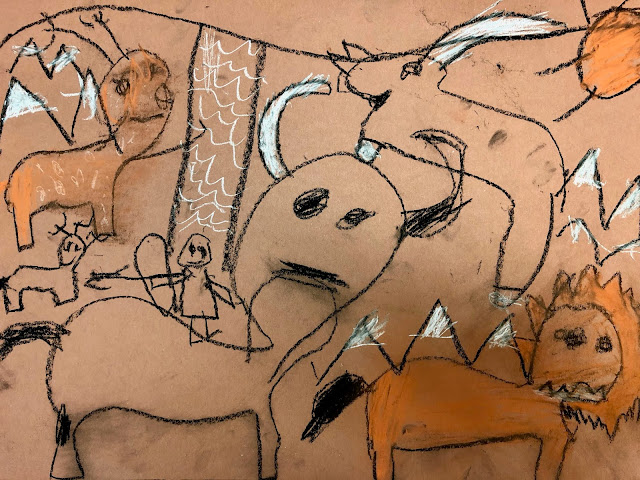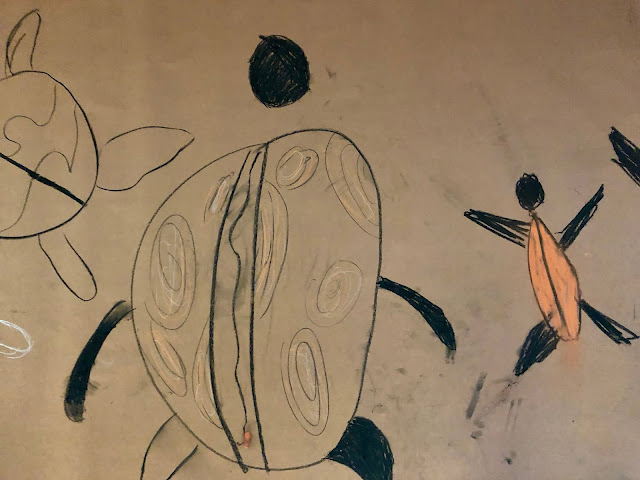This is probably my favorite lesson to teach.
I Love ancient art.
You will need:
You can also add white chalk and large brown paper on a roll to make big cave drawings.
I start the lesson by reading this wonderful story:
This book is perfect for this lesson with wonderful illustrations!
Next I show them slides from Lascaux, Chauvet and other pictographs and petroglyphs to show them the variety of art they can use for inspiration.
Ice Age Paleolithic Cave Paintings
I introduce them to the story of Lascaux and how it was discovered by teenage boys whose dog had gotten into a hole which led to the cave.
I ask them questions about the slides, such as what do they see? How was this made? What did they use for paint, etc...
Lascaux Cave was discovered in France On September 12, 1940, the entrance to the Lascaux Cave was discovered by 18-year-old Marcel Ravidat who returned to the scene with three friends, Jacques Marsal, Georges Agnel, and Simon Coencas. They entered the cave through a (49 ft) deep shaft to rescue their dog which had fallen into the hole. The teenagers discovered that the cave walls were covered with depictions of animals. The cave complex was opened to the public on July 14, 1948. By 1955, carbon dioxide, heat, humidity, and other contaminants produced by 1,200 visitors per day had visibly damaged the paintings. As air condition deteriorated, fungi and lichen increasingly infested the walls. Consequently, the cave was closed to the public in 1963, the paintings were restored to their original state and a monitoring system on a daily basis was introduced.
Lascaux II, an exact copy of the Great Hall of the Bulls and the Painted Gallery opened in 1983 in the cave's vicinity (about 200 m. away from the original cave), a compromise and attempt to present an impression of the paintings' scale and composition for the public without harming the originals. The paintings for this site were duplicated with the same type of materials as iron oxide, charcoal and ochre which were believed to be used 19 thousand years ago.
I can't imagine shining my light onto the cave walls and seeing all of these amazing paintings!
Next I introduce the Chauvet Cave also in France which wasn't discovered until 1994 because a rock slide had hidden the entrance for at least 30,000 years. It was happened upon by a small team of cavers led by Jean-Marie Chauvet. This cave was immediately sealed to make sure it didn't deteriorate like Lascaux. They have created an exact duplicate for the public to visit.
It's exciting that these discoveries are still being made!
It's exciting that these discoveries are still being made!
I like them to see a large variety of animals and styles.
I show several other examples of Pictographs and Petroglyphs, some from Africa with Giraffes etc... Just so they can see how this art is all around the world. I end with Native American Petroglyphs of bighorn sheep etc...
We also talk about how they didn't have a written language and that these handprints have been found in caves all around the world.
Next I pass out brown 12X18" paper and charcoal. You can just let them start drawing or if they are younger students give them some quick animal drawing tips to get them started.
I turn off the lights in the classroom and play Native American Flute music, they are instructed not to use any words or modern day images. They can put their names on the back, their handprint on the front. They are cave artists for this class, working in dim light just like artists from that time. Once they finish their individual drawing they can take their drawing tools to the large paper cave wall on the floor and do a class cave art drawing.
2nd Grade examples:
We talk about how large these paintings are, the one in Lascaux of the Bull is 17' long!
Large paper roll cave wall Examples:
A herd of wild Przhevalsky horses in the Chernobyl exclusion zone. Photograph: Tatyana Deryabina/University of Porthmouth. & a 17,000-year-old horse painting at the Lascaux cave in France






































No comments:
Post a Comment
Note: Only a member of this blog may post a comment.